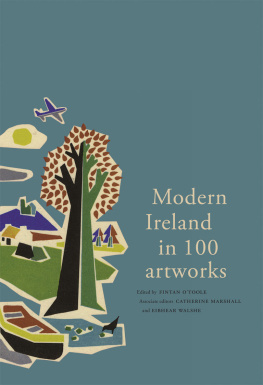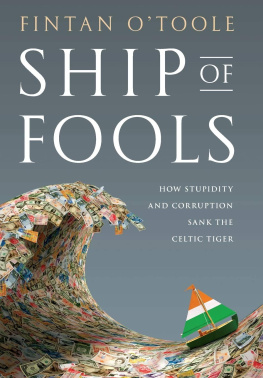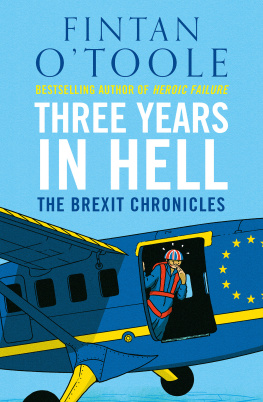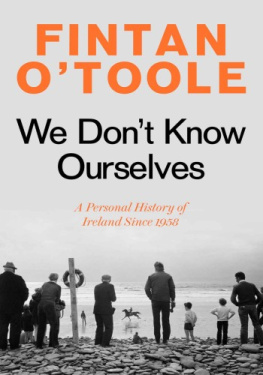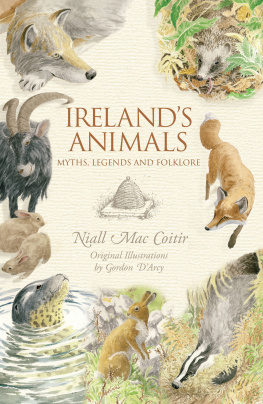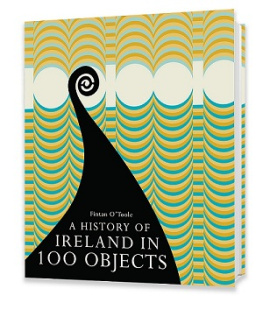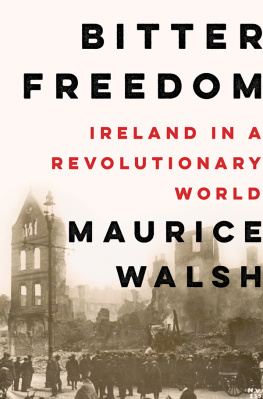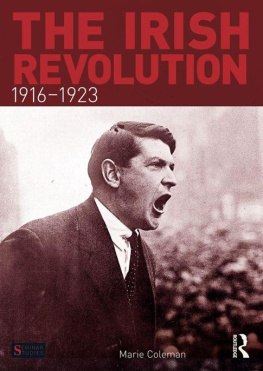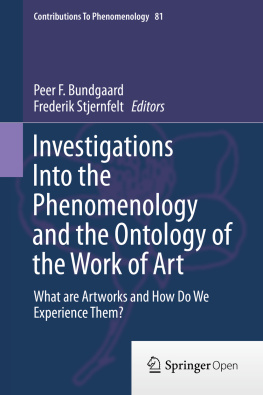Fintan OToole - Modern Ireland in 100 Artworks
Here you can read online Fintan OToole - Modern Ireland in 100 Artworks full text of the book (entire story) in english for free. Download pdf and epub, get meaning, cover and reviews about this ebook. year: 2016, publisher: Royal Irish Academy, genre: Science. Description of the work, (preface) as well as reviews are available. Best literature library LitArk.com created for fans of good reading and offers a wide selection of genres:
Romance novel
Science fiction
Adventure
Detective
Science
History
Home and family
Prose
Art
Politics
Computer
Non-fiction
Religion
Business
Children
Humor
Choose a favorite category and find really read worthwhile books. Enjoy immersion in the world of imagination, feel the emotions of the characters or learn something new for yourself, make an fascinating discovery.
- Book:Modern Ireland in 100 Artworks
- Author:
- Publisher:Royal Irish Academy
- Genre:
- Year:2016
- Rating:5 / 5
- Favourites:Add to favourites
- Your mark:
- 100
- 1
- 2
- 3
- 4
- 5
Modern Ireland in 100 Artworks: summary, description and annotation
We offer to read an annotation, description, summary or preface (depends on what the author of the book "Modern Ireland in 100 Artworks" wrote himself). If you haven't found the necessary information about the book — write in the comments, we will try to find it.
100 artworks have been chosen for this beautifully illustrated book to represent each year from 1916-2015. They trace the story of Irelands creative output from the revolutionary period until today.
Modern Ireland in 100 Artworks — read online for free the complete book (whole text) full work
Below is the text of the book, divided by pages. System saving the place of the last page read, allows you to conveniently read the book "Modern Ireland in 100 Artworks" online for free, without having to search again every time where you left off. Put a bookmark, and you can go to the page where you finished reading at any time.
Font size:
Interval:
Bookmark:
Modern Ireland
in 100 artworks
Edited by
Fintan OToole
Associate editors
Catherine Marshall and Eibhear Walshe

Modern Ireland in 100 artworks
First published 2016
Royal Irish Academy, 19 Dawson Street, Dublin 2
www.ria.ie
Text copyright the RIA, The Irish Times and the writers
ISBN 978-1-908997-02-9
All rights reserved. The material in this publication is protected by copyright law. Except as may be permitted by law, no part of the material may be reproduced (including by storage in a retrieval system) or transmitted in any form or by any means; adapted; rented or lent without the written permission of the copyright owners.
British Library Cataloguing in Publication Data. A CIP catalogue record for this book is available from the British Library.
Copyeditor: Maggie Armstrong
Design: Fidelma Slattery
Picture research: Niamh Mongey
Index: Eileen ONeill
Printed in Italy by Printer Trento
10 9 8 7 6 5 4 3 2 1
Introduction
Can modern Ireland be represented in 100 artworks? This was the exciting challenge set to us by the Royal Irish Academy and The Irish Times, as a unique way of marking a century of creativity in a year of commemorations. Artists, both literary and visual, were crucial during this tumultuous period, in which we were remaking and interrogating our sense of ourselves as Irishnorth and south, women and men, poets, painters, architects, practitionersacross a wide range of disciplines. Our project, therefore, was to map a century of creativity by selecting 100 artworks made from 1916 to 2015, using each year to gradually assemble a cumulative sense of an evolving creative culture, which in turn mirrored the modernisation of the state. This proved to be a demanding and thought-provoking project for everyone involved coming from our varied disciplines.
This book takes as its starting point 1916, the year of the Easter Rising. It seems a good place to begin to look at the emergence of both Modernism and nation-building; the emergence of an independent nation, the first wedge in the cracking open of a great empire; and a period during which scientific and social change advanced at a pace never experienced before. The trial and execution of Roger Casement, one of the active participants in the Rising, led directly to two creative responses in that year, one literary and theatrical and the other a painting, not widely known until relatively recently. These were the speech offered by George Bernard Shaw, the countrys most famous living playwright, to Casement to be delivered at his appeal trial against his conviction and sentence to death, and a painting discussed in the entry for 1930 of that same event by Sir John Lavery, one of the countrys most acclaimed painters. Shaw and Lavery were not the only writers and artists to respond to the same events in the unfolding history from 1916 onward, yet curiously, Modern Ireland in 100 artworks is a unique project within Irish cultural history. It is the first occasion on which the literary and visual arts were jointly tasked with representing an important and sustained period in the countrys history.
The past is usefully narrated and analysed by historians but no matter how comprehensive their work is, the story of a people can never be told without its artistic representation, without what the painter Hughie ODonoghue referred to as the truth as it is felt. For this reason the invitation issued by the Academy and The Irish Times was not only challenging but one that carried a big responsibility. Our concern was not just to represent our various and separate disciplines but also to reflect the imaginative and emotional life of the country during the period of our task. The structure imposed by the brief required us to select one work to represent each year of the century while at the same time working to provide a balance between the disciplines. Such a balance has not been a feature of Irish cultural history to date. The chronological structure meant that for some years we were spoiled for choice, with an abundance of literature and art; for other years we were hard-pressed to find suitable material from either discipline. Where this happened we decided that the quality of the representation outweighed the need for an equality of numbers between the visual and literary. Thus, we did not achieve the perfect 5050 balance we would have liked between, for instance, the visual and the literary arts, or between the male and the female, but we accepted that an imbalance was part of the historical narrative. To have played god with that was not a valid option.
The task initiated a discussion about the relationship between the interconnecting and the disparate areas of the visual arts and literary production over the last 100 years. Usefully, the constraints of the time-frame sharpened our discussion and made us focus on our sense of what should best represent both the many artists working throughout this period and also the developing history. It was an exciting process because it brought those who work in literary studies into close and valuable discussion with scholars of the visual arts, as we considered the underlying connections between various forms and expressions of the imagination in modern Ireland. We hope that this final selection, the result of much argument and counter-argument, gives us a revealing and illuminating account of the progressive development of the arts in Ireland over 100 years, not least because writers and visual artists are, for the first time, placed side by side in such a context. Of course there have been collaborations between writers and artists in the past in Ireland. We think of the Great book of Ireland, itself a response to the medieval Book of Kells, and more recent collaborations between writers such as Paul Durcan and the National Gallery of Ireland, or Seamus Heaney and Barrie Cooke, to name just two of many, but absolutely nothing existed of the spread and ambition of this centennial project. It was challenging, too, because of the obvious limitations placed on our selections by genre and by the ebb and flow of creativity within this century of Irish imaginings.
Writers and artists do not produce their work to fit in with chronological order. It was fascinating to observe, as we compiled our lists, that there were moments of intense creative flowering in particular decades, the 1960s being one clear example. The visibility of Irish women artists and writers was somewhat problematic, however, as we shall discuss below. Not being Irish or Irish enough has meant exclusion from Irish literary culture for many artists. In our selection we opted, wherever possible, to include those artists and writers who have commented usefully on both Irishness and Modernism, such as Heinrich Bll and Sybil Connolly; those who, if not born here, worked here for many years. We also sought to give visibility to people whose careers were largely played out abroad yet whose work reflected their Irish experience, such as Elizabeth Bowen and Brian ODoherty. As the century progressed, new art forms and influences profoundly altered the kinds of art and literature produced in Ireland and our selection reflects these new forms and the exciting work that burst forth in response to national and international events. Although our process prioritised the creativity of the century it also, therefore, offered an indirect mapping of modern Ireland. Each individual artistic perspective and each book, poem, painting, sculpture, building or installation provides another original insight into the idea of Irishness for our cumulative account of writing and art-making.
Overall, these vital decades of nation-building, of rebellion and civil war, of censorship, of migration and exile, of cultural renaissance, of international travel and new communication systems and of boom and bust, were always being observed and tested by artists. Often the aesthetic response was one of dissent, unease, questioning and disquiet. Each of the works selected represents both the private vision of an artist and, at the same time, is part of the cultural context, the contemporary zeitgeist that informed each private vision.
Next pageFont size:
Interval:
Bookmark:
Similar books «Modern Ireland in 100 Artworks»
Look at similar books to Modern Ireland in 100 Artworks. We have selected literature similar in name and meaning in the hope of providing readers with more options to find new, interesting, not yet read works.
Discussion, reviews of the book Modern Ireland in 100 Artworks and just readers' own opinions. Leave your comments, write what you think about the work, its meaning or the main characters. Specify what exactly you liked and what you didn't like, and why you think so.

